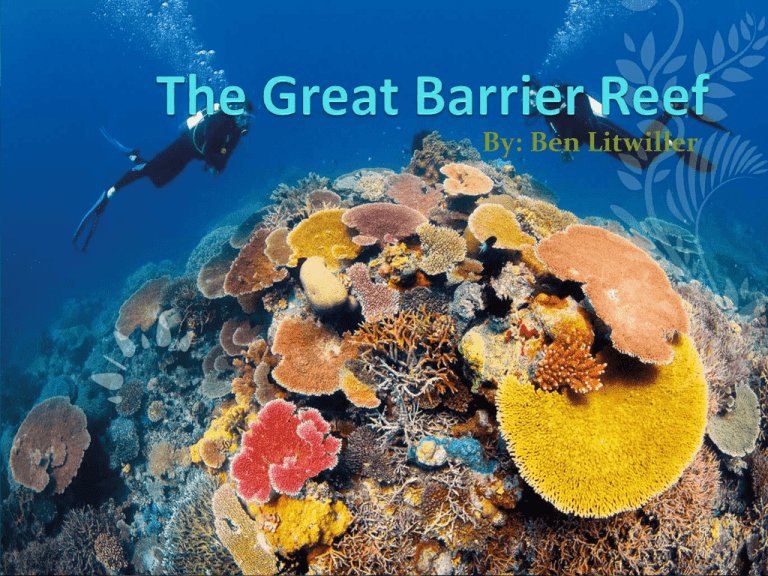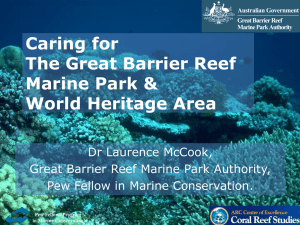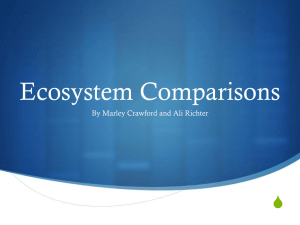
By: Ben Litwiller
Intro.
http://video.nationalgeographic.com/video/place
s/parks-and-nature-places/oceans/oceansbarrier-reef/
Location
The great barrier reef is located out the northeast
shores of Australia.
Topography
largest extent of coral reefs on Earth
geographic range (24°30'N to10°41'S, 145°00' to
154°00'E)
extends for more than 2000 kilometres within the
Coral Sea off the eastern coast of Australia.
Climate
Climate
Climate
Climate
Plants
Mangroves
make up the third type of plant growing near reefs
More than 50 species of mangroves exist in the world.
Florida's boasts about 469,000 acres
found along the state's southern coast.
Plants
Of some 60 species of seagrass around the world,
there are 30 in Australia and 15 in Queensland
waters.
*Seagrasses are different to
seaweeds and algae
*true roots and are the only
flowering plants in the sea.
Starfish in seagrass.
*They are important food for
turtles and dugongs.
Plants
500 species of seaweed or marine algae live on the
Great Barrier Reef
*Most seaweeds are not
poisonous to humans but a few,
such as Caulerpa
Plants
Blue-green algae
are more appropriately known as cyanobacteria
originally thought to be a type of algae
bacteria form green tufts on the reef
which forms sometimes forms blooms in tropical
waters.
Plants
Brown algae
contain an extra pigment
abundant in cooler climates
a few species can be very common in summer on
inshore
Plants
Golden algae
are concerned about extensive blooms of seabed algae
known as 'golden noodle algae
Scientists have identified the bloom-forming alga as
Chrysocystis fragilis
has been found at Palau, Pohnpei and Hawaii.
Endangered Animals
Whales and dolphins
Dugong
Marine turtles
get tangled up in fishing lines
Animals
30 species of whales, dolphins and porpoises live in,
or visit Great Barrier Reef waters
*Visit the Reef every year in
June and July.
*They feed by straining tiny
plankton and krill
Dwarf minke whale.
Animals
Some of the largest populations of dugongs in the
world live on the Great Barrier Reef
*Dugongs grow to about 3m long
*Can weigh 400 kg
*live to 70 years old.
Dugongs.
*Dugongs have a single calf
when they are between 6-17 years
old
Animals
Over 200 species of birds (including 40 species of
seabirds) live on the Great Barrier Reef
*White-breasted sea eagles live
on the coast and islands.
*The Roseate tern migrates as
far as Japan.
White-breasted sea eagle.
Animals
Six breeding species of sea turtles live on the Great
Barrier Reef
*temperature of the sand
determines the sex of the young
turtles.
*Cooler sand produces male
turtles
Green turtle hatchling.
Measuring a Loggerhead turtle.
*warmer sand produces females.
Animals
14 species of sea snakes live on the Great Barrier
Reef
*evolved in the sea about 135
million years ago.
*Sea snakes have to come to the
surface to breathe
Seasnake.
*but can spend up to 2 hours
underwater between breaths.
More Animals
1500 species of fish live on the Great Barrier Reef
*baby anemone fish can swim at
9.5 body lengths per second
*The oldest fish on the Great
Barrier Reef would be a red bass
Clown anemone fish.
Coral trout.
Strange Animals
5,000 species of molluscs live on the Great Barrier
Reef
*Giant clams can grow to be
more than 1 metre long
*can be at least 70 years old.
*They are the largest bivalve
mollusc
Giant clam.
*Nudibranchs are a type of sea
snail
*Adult nudibranchs have a
multi-coloured mantle instead of
a shell.
Nudibranch.
People
People can go snorkeling, diving,
helicopter rides and cruises
NO HURLIN ON
THE SHELL DUDE
People
Great Barrier Reef contributes $6.4 billion a year
from the tours
employs more than 60,000 people.
The interconnected reef system faces increasing
pressure from climate change
Jobs for people
Aquariums
Visitor service officer
Marine Biologists
Fishermen
Tour Guides
Unique Features
the clownfish can actually help the sea anemones to
breathe and can help them to aerate themselves
Sea anemones gives the clownfish a place to live in
exchange
http://video.nationalgeographic.com/video/coralreefs
There are more symbiotic relationships similar to this
found in the G.B.R.
Relationships
Commensalism
the pearlfish uses the sea cucumber for a hide-out from
predators
lives in the sea cucumber’s anus
Mutualism
orange coral crab lives in and feeds off of the coral
coral benefits as the resident crab cleans it and protects
it
Parasitism
Sea spider gains food and nutrients from coral
this relationship bleaches the coral
Coral
Attached to the ocean floor
Waste produces products for photosynthesis for the
algae
Algae produces products need for the coral to grow
Is home for most animals in the reef
Environmental concerns
lost more than half its coral cover in the past 27 years.
Experts say storms, starfish and bleaching linked to climate change are
to blame.
Environmental concerns
global warming
overuse from tourism
Fishing
farming
development on the coast and pollution both in
the water and on the land.
Before
After
Solving the problems
* 30-50% of reefs to be set aside as "no take" or no
fishing zones for long term protection
* larger fines for fishing offenses
* greater use of technology to enforce no fishing zones.
Conclusion
Beautiful place
Cool animals
All around fun place to go on vaction.
Food web of the G.B.R.
=P
=P.C.
=S.C.
=T.C.
5 questions
What are the four endangered species I minced in the
P.P.?
What can people do when visiting the reef?
What is the biggest problem with keeping the reef
healthy?
What is the olds fish in the G.B.R.?
How many speices of sea snakes are there?
The websites
http://en.wikipedia.org/wiki/Great_Barrier_Reef
http://www.cairns-greatbarrierreef.org.au/media/6481/diving_experiencecairns_great_barrier_reef.jpg
http://www.deepreef.org/publications/peer-review/87-topography-gbr.html
http://www.reef.crc.org.au/discover/plantsanimals/facts_plantanimal.htm
http://wwf.panda.org/about_our_earth/about_freshwater/rivers/irbm/cases/great_barrier_reef_cas
e_study/
http://www.environment.gov.au/topics/environment-protection/strategic-assessments/greatbarrier-reef
http://cdn.greatbarrierreef.com.au/wp-content/uploads/2012/10/Great-Barrier-Reef-Food-Web-Diagram1.jpg
http://www.oceanwideimages.com/images/8302/large/mangrove-jack-24M1844-12.jpg
http://traveltips.usatoday.com/plants-live-coral-reefs-61384.html
http://disc.sci.gsfc.nasa.gov/education-and-outreach/additional/science-focus/images/coral_reef_algae.jpg
http://www.reef.crc.org.au/discover/plantsanimals/algae/
http://tolweb.org/tree/ToLimages/kelpy3.250a.jpg
http://www.conservenature.org/learn_about_wildlife/great_barrier_reef/commensalism.htm
http://switchboard.nrdc.org/blogs/fbeinecke/Healthy.coral.reef.No.Title.jpg
http://awsassets.wwf.org.au/img/mo_corals_anthias_fish_fiji_808x236_4919.jpg










